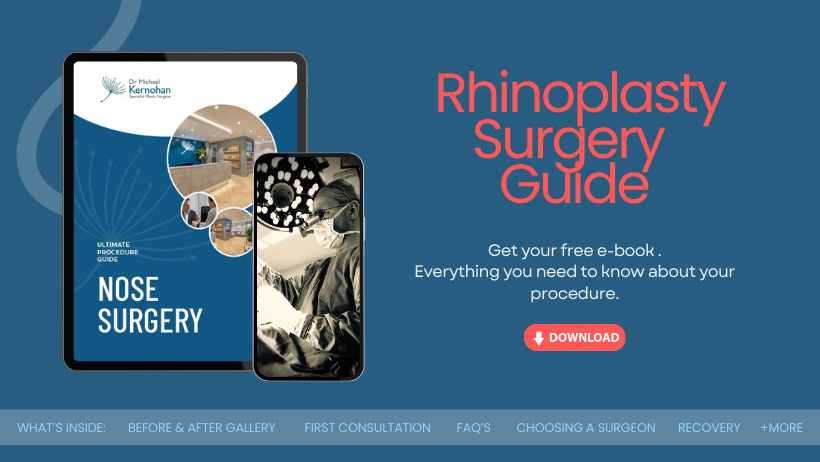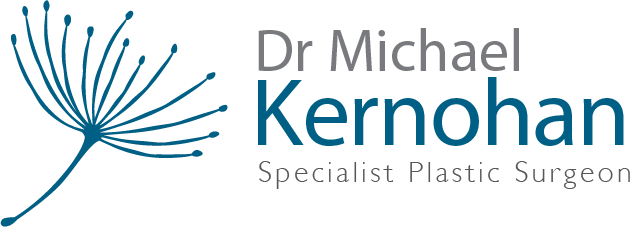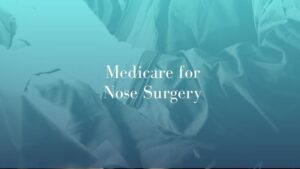How Is Cartilage Graft Used for Rhinoplasty
A cartilage graft nose job, also known as rhinoplasty with cartilage grafts, is a surgical procedure aimed at reshaping and enhancing the nose using cartilage grafts. It involves the transplantation of cartilage from one part of the body to the nose to improve its structure, shape, and functionality.
In rhinoplasty, cartilage grafts are utilised to address various aesthetic and functional concerns. The importance of cartilage in this procedure lies in its ability to provide structural support, shape, and stability to the nose. Cartilage grafts for rhinoplasty can be obtained from different donor sites within the patient’s own body, such as the ribcage, septum or ears.
Specialist Plastic Surgeon Dr Michael Kernohan is a highly regarded plastic surgeon based in Sydney regularly performing nose procedures.
Take the Quiz
What Is Cartilage?
Cartilage is a type of connective tissue found in various parts of the body. It is a firm and flexible material that provides structural support and acts as a cushion between bones, allowing for smooth joint movement. Unlike bone, cartilage does not contain blood vessels or nerves, giving it a smooth and rubbery texture.
Imagine a substance that is firm yet flexible, like a gentle cushion between bones, allowing them to glide effortlessly. That is cartilage—a connective tissue that plays a vital role in our bodies, providing strength, stability, and elasticity.
When Is Nose Cartilage Grafting Needed?
Nose cartilage grafting is needed in various situations where additional structural support or enhancement is required during nasal surgery. Here are some common scenarios when nose cartilage grafting may be necessary:
- Nasal deformities: Nose cartilage grafts are often used to address congenital or acquired nasal deformities. These may include a crooked or twisted nose, a collapsed nasal bridge, or asymmetry. The grafts help to reshape and realign the nasal structures, creating a more balanced and harmonious appearance
- Nasal bridge augmentation: In cases where the nasal bridge is too flat or lacks sufficient height, cartilage grafts can be employed to augment and build up the bridge. This can enhance the overall contour of the nose, creating a more defined appearance
- Nasal tip refinement: Cartilage grafting is frequently utilised to refine and reshape the nasal tip. The grafts can provide increased projection, definition, and support to a droopy or bulbous tip, resulting in a more refined and balanced nasal tip appearance
- Revision rhinoplasty: When correcting a previous unsatisfactory nose surgery, cartilage grafting is often necessary. It allows the surgeon to rebuild and strengthen the nasal framework, addressing issues such as over-resection of cartilage, asymmetry, or collapse
- Nasal airway reconstruction: In cases of nasal valve collapse or other structural issues that impede breathing, cartilage grafting can be used to reinforce and open up the nasal airway. By providing structural support, the grafts help improve airflow and alleviate breathing difficulties
Sources of Nose Grafts
Nose grafts can be obtained from various sources within the body, providing the necessary material for rhinoplasty procedures. Here are the common sources of nose grafts:
- Septum: The septum is the thin wall of cartilage and bone that separates the left and right nasal cavities. It is an ideal source for grafts as it is readily accessible during rhinoplasty. Harvesting septal cartilage does not require an additional incision, making it a preferred choice for many surgeons
- Ear: The ear is another source of cartilage grafts for nasal surgery. Specifically, the auricular cartilage, which forms the structure of the outer ear, can be harvested. It is flexible, pliable, and offers a sufficient amount of cartilage for grafting purposes
- Rib: In some cases, rib cartilage may be used as a graft source, particularly when a larger volume of cartilage is needed. The cartilage is harvested from the patient’s ribcage, usually from the rib that runs along the bottom edge. This technique is employed for complex nasal reconstructions or revision rhinoplasty
Benefits and Advantages of Cartilage Graft Nose Jobs
Cartilage graft nose jobs offer numerous benefits and advantages, providing patients with the opportunity to enhance both the aesthetics and functionality of their nose. Here are some benefits:
- Improved nasal shape and symmetry: Cartilage grafts allow for precise reshaping and sculpting of the nose, resulting in improved symmetry and a more balanced facial appearance. Whether you desire a refined nasal tip, a straighter bridge, or overall harmonisation, cartilage grafts can help achieve the desired shape and proportions
- Enhanced structural support and stability: By utilising cartilage grafts, plastic surgeons can provide additional support to the nasal framework, ensuring long-term stability and structural integrity. This can be particularly beneficial for individuals with weak nasal cartilage or previous nasal surgeries that have compromised the structure of the nose
- Natural-looking results: Cartilage grafts offer a natural solution for nose reshaping. As they are derived from the patient’s own tissues, they seamlessly integrate with the existing nasal structures, resulting in outcomes that look and feel natural. The use of cartilage grafts helps to avoid an artificial or “operated” appearance
- Long-lasting outcomes: Cartilage grafts have good longevity, providing enduring results over time. Unlike temporary fillers, which may require periodic touch-ups, cartilage grafts offer a more permanent solution. The grafts maintain their shape and stability, ensuring that the achieved results can last for years
- Improved breathing and airflow: In addition to aesthetic benefits, cartilage grafts can also enhance nasal function by improving breathing and airflow. Grafts can be used to address structural issues, such as a deviated septum or collapsed nasal valves, helping to alleviate breathing difficulties and optimise nasal airflow
These benefits collectively make cartilage graft nose jobs a popular choice for individuals seeking both cosmetic enhancements and functional improvements.
Rhinoplasty Guide

Comparing Cartilage Graft Nose Jobs with Other Rhinoplasty Techniques
When considering nose reshaping, it’s essential to understand the different approaches available. Let’s compare cartilage graft nose jobs with traditional rhinoplasty methods and non-surgical nose reshaping options, exploring their benefits and limitations:
Cartilage Graft Nose Jobs
Benefits
- Precise shaping and sculpting of the nose using cartilage grafts for natural-looking results
- Enhanced structural support and stability for long-lasting outcomes
- Improved breathing and airflow by addressing functional concerns
Limitations
- Invasive surgical procedure requiring a recovery period
- Potential risks associated with surgery, such as bleeding or infection
- Requires a skilled surgeon with expertise in cartilage grafting techniques
Traditional Rhinoplasty Methods
Benefits
- Comprehensive reshaping of the nose, addressing various aesthetic concerns
- Ability to modify bone and cartilage structures for significant changes
- Permanent results with a long-lasting impact on the nasal appearance
Limitations
- Invasive surgery with associated risks and a longer recovery period
- Potential for more noticeable scarring compared to non-surgical options
- Requires general anaesthesia and more extensive pre-operative evaluation
Non-surgical Nose Reshaping Options
Benefits
- Non-invasive or minimally invasive procedures with little to no downtime
- Temporary results that can be adjusted or reversed if desired
- Limited risks and complications compared to surgical methods
Limitations
- Limited ability to address structural issues or major reshaping needs
- Results are temporary and may require periodic touch-ups
- May not be suitable for patients with significant nose deformities or functional concerns
It’s important to note that the suitability of each approach depends on your specific needs, goals, and anatomical considerations.
FAQ’s Regarding Cartilage Graft Nose Jobs
When can I resume normal activities after cartilage nose grafting?
The timeline for resuming normal activities after a cartilage graft nose job can vary from patient to patient and depends on several factors, including the extent of the surgery and individual healing rates. However, here are some general guidelines:
- Immediate post-operative period: Immediately after the surgery, you will need to rest and recover. You may experience swelling, bruising, and discomfort around the nose and possibly other areas of the face.
- First week: During the first week, it’s recommended to take time off from work or school to allow your body to heal. You should avoid strenuous activities, such as exercise, heavy lifting, or activities that may increase blood pressure or risk of injury to the nose
- Second week: By the second week, you may start to see improvements in swelling and bruising. Dr Kernohan will likely schedule a follow-up appointment to monitor your progress. At this stage, you may be able to engage in light activities, but it’s still crucial to avoid any activities that could put stress on your nose
- Weeks 3-4: As the healing process continues, you may gradually resume more normal activities. However, it’s important to avoid activities that could potentially impact or injure the nose, such as contact sports or activities with a high risk of accidental trauma
- Weeks 4-6 and beyond: By this stage, most patients can resume their normal activities, including exercise and sports, as long as they feel comfortable and have received clearance from Dr Kernohan. However, it’s essential to continue protecting your nose from any potential trauma during these activities
How long do the results of a cartilage graft nose job last?
- The results of a cartilage graft nose job are long-lasting. Cartilage grafts provide structural support and stability, allowing the reshaped nose to maintain its form over time. However, natural ageing processes and other factors can still affect the appearance of the nose in the long term.
Are cartilage grafts safe for everyone?
- Cartilage grafts are generally considered safe. However, certain medical conditions or factors, such as previous nasal surgeries or significant nasal deformities, may impact the suitability of using cartilage grafts. It is crucial to consult with a specialist plastic surgeon who can assess your specific case and determine the appropriateness of cartilage grafting for your nose job.
Can I combine a cartilage graft nose job with other cosmetic procedures?
- Yes, it is possible to combine a cartilage graft nose job with other cosmetic procedures, depending on your goals and individual circumstances. Common combinations include addressing chin augmentation, lip augmentation, or eyelid surgery alongside a cartilage graft nose job. Dr Kernohan will evaluate your suitability for combined procedures and guide you accordingly.
Is the procedure painful?
- The procedure itself is performed under anaesthesia, so you will not experience pain during the surgery. However, it is common to experience some discomfort, swelling, and bruising in the post-operative period.
What are the risks of cartilage graft nose jobs?
- As with any surgical procedure, cartilage graft nose jobs carry potential risks. These can include infection, bleeding, adverse reactions to anaesthesia, scarring, asymmetry, or dissatisfaction with the aesthetic outcomes. It is important to thoroughly discuss the risks and benefits with Dr Kernohan and follow his post-operative instructions for a smooth recovery.
Further Reading about Nose Procedures with Dr Kernohan
- Read Dr Kernohan’s Rhinoplasty Nose Surgery Page
- Read Dr Kernohan’s Septoplasty Surgery Page
- Read Dr Kernohan’s Alarplasty Surgery Page
- Read Dr Kernohan’s Blog about What is a Bulbous Nose? – Nose Surgery Options
- Read Dr Kernohan’s Blog about How to Make Your Nose Smaller
- Read Dr Kernohan’s blog about Will Medicare Cover My Nose Surgery/ Rhinoplasty?
Medical References about Cartilage Graft Nose Job
- Costal Cartilage Grafts in Rhinoplasty – NCBI
- Rhinoplasty Surgery (Nose Job): Purpose, Procedure – WebMD
- Rhinoplasty: Motives, Procedure, and Results – Medical News Today
- Rhinoplasty – Mayo Clinic









